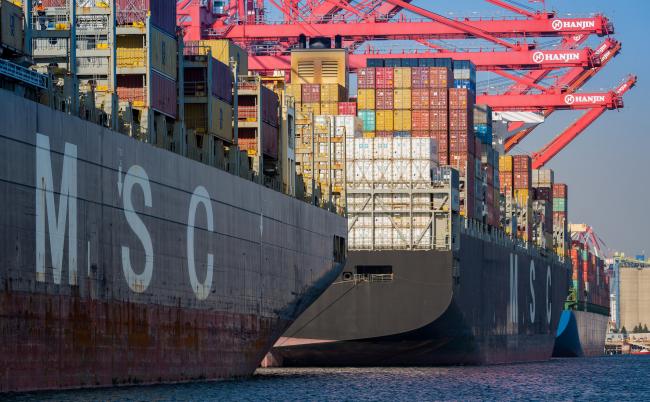 © Bloomberg. Cargo ships line up at the Total Terminals berth at the Port of Long Beach in Long Beach, California, U.S., on Wednesday, April 4, 2018. The U.S. trade deficit widened by more than forecast to a fresh nine-year high in February amid broad-based demand for imports, ahead of Trump administration tariffs that have raised the specter of a trade war.
© Bloomberg. Cargo ships line up at the Total Terminals berth at the Port of Long Beach in Long Beach, California, U.S., on Wednesday, April 4, 2018. The U.S. trade deficit widened by more than forecast to a fresh nine-year high in February amid broad-based demand for imports, ahead of Trump administration tariffs that have raised the specter of a trade war.(Bloomberg) — Federal Reserve policy makers have been publicly cautious about what a U.S. trade dispute with China could mean for their outlook if it escalates, but investors will get a peek at what they really think when the central bank publishes an .
“For now, the stock market is very hung up on the issue,” said Stephen Stanley, chief economist at Amherst Pierpont Securities LLC. “The Fed’s view has been this is at an early stage and it doesn’t affect the outlook yet. Investors will be very curious if there is anything in the minutes.”
Minutes of the closed-door March 20-21 meeting of the Federal Open Market Committee, the first under incoming Chairman Jerome Powell, will be released at 2 p.m. on Wednesday in Washington. As the FOMC deliberated, the Trump administration was considering tariffs on Chinese imports, the prospect of which helped send stocks tumbling by almost 6 percent that week.
Still, the FOMC raised interest rates last month for the sixth time since December 2015, penciled in two or three additional increases this year and forecast a steeper path of hikes in 2019 and 2020 against the backdrop of an improved economic outlook. The subject of looming trade disputes likely was part of the discussion of risks.
Powell, giving his first speech as chairman on Friday, didn’t mention the Trump administration’s trade dispute with China in his prepared remarks. He subsequently told a questioner that the central bank’s business contacts have described trade disputes as “a bit of a risk” to the outlook. Fed officials updated quarterly projections for the economy for the March meeting.
Read More About Trump’s Proposed Tariffs on Chinese Imports
“Tariffs were likely not incorporated in the forecasts because the details were — and still are — scant,” said Roberto Perli, a partner at Cornerstone Macro LLC said. “But it will be interesting to see what and how serious they thought the impact could be. In other words, it would be interesting to see if trade issues changed their views of risks, and if so of how many people.”
Tariffs could raise some prices, which officials may view as a one-time shock that they’d look through, much like a jump in oil prices rather than a lasting source of inflation. Escalating trade protectionism could also slow growth, increasing the caution of policy makers, and financial market volatility since Trump announced tariffs on Chinese goods has already tightened financial conditions somewhat, back to levels at the end of last year.
There’s reason for concern if trade issues “dampen animal spirits and adversely weigh upon business spending,” which is likely to be the faster-growing area of the economy through 2020, said John Herrmann, director of U.S. rate strategy for MUFG Securities.
A few Fed officials have publicly worried about trade disputes. San Francisco Fed President John Williams, who’ll take over the helm of the Fed’s powerful New York branch in June, warned that continued escalation “could have some pretty negative repercussions.” St. Louis Fed President James Bullard said trade could affect interest rate policy.
|
What Our Economists Say “The minutes of the March FOMC meeting may be subject to heightened scrutiny given that it was the first gathering presided over by Chairman Jerome Powell. As such, Fed watchers will aim to glean any indications of how the Powell regime may operate differently than that of Janet Yellen.” |
While the FOMC was about evenly split on forecasting three or four rate hikes this year, a reduction in growth and inflation could dampen the appetite to boost rates.
The Fed’s assessment of inflation will also shape how aggressively policy makers decide to raise interest rates this year. U.S. consumer prices rose 2.4 percent in the 12 months through March, data from the Labor Department on Wednesday showed, the highest level in a year. Excluding food and energy, the core consumer price index rose 2.1 percent.
The Fed prefers a different inflation measure, produced by the Commerce Department, which will be updated April 30. Powell on Friday expressed confidence that price pressures according to that gauge will move up in coming months as weak readings from 2017 drop out of year-over-year measures.
(Updates with March CPI data in 11th paragraph.)
Source: Investing.com


























